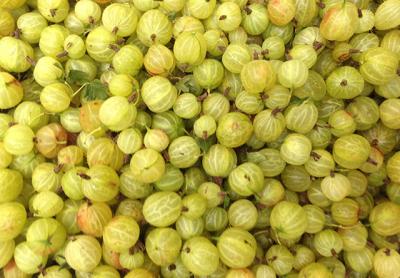Gooseberries and Red Currants

Summertime is berry-picking time, and for those of us lucky to have berries in our gardens, it is also a time of challenges: getting to the ripened berries before the birds do, picking the berries before they rot or fall, and — in the case of the weekend gardener — remembering what weekend the berries will come in, so that we can clear our schedules and devote ourselves full-time to gathering them, processing them, and putting them up as jams for the coming year. One berry, however, makes all of this easy for me: the gooseberry.
Gooseberries — and a related berry, the red currant — have never achieved the popularity in the United States that they have in Europe, where both are hailed for their delicious flavor as well as for their performance in both garden and kitchen. They make exceptionally good jams, containing enough natural pectin that they require nothing more than the right proportion of sugar to achieve a good set, and both containing enough natural acidity that they will retain a fine, bright flavor long after canning. Both are easy to cultivate, too: They enjoy growing in part shade, are susceptible to only a few diseases, and are rarely eaten by birds or squirrels — unlike blueberries or strawberries, which can disappear at an alarming rate into the mouths of our appreciative local wildlife. Also, both gooseberries and red currants will stay on the bush for a very long time — so if you miss picking them one weekend, they will most probably be waiting for you the next.
Given all these fine attributes, you may wonder why gooseberries aren’t more popular. They were in the last century, but starting in the early 1900s their cultivation was outlawed in many parts of the Northeast and Mid-Atlantic because they were found to host white pine blister rust, a killer of valuable white pine trees. (Only in 1966 did New York State rescind the ban, when new, non-rust-hosting cultivars of the fruits became available; but even today, the bushes remain illegal in parts of New Jersey and Massachussetts.)
Another reason that gooseberries and red currants are not overly popular is that they are highly acid, and most people who sample them find them too sour. Finally, gooseberries are thorny, and red currants, though not thorny, are fragile, growing in long, delicate clusters that are difficult to harvest commercially. So if you want to enjoy these delicious berries — and to my mind, they are best enjoyed as jam — you’ll probably need to grow a few bushes at home. Luckily, doing so is not too difficult.
Gooseberries come in two types: American and European. American gooseberries are smaller, healthier, and more productive, while European varieties are larger and a bit less acidic. I have three kinds in my garden: Hinnonmaki Red and Pixwell, both of which are American, and Invicta, a European gooseberry that is said to be the best gooseberry available in North America, with larger, sweeter fruit. I purchased all three varieties locally at Lynch’s Garden Center in Southampton and can’t really tell the difference between them, except that the Hinnonmaki Red are a deep ruby red, while the others are a very pretty chartreuse. I have several varieties of currants — including red currants, white currants, and black currants — but I would only recommend red currants, specifically the cultivar “rovada,” which is agreed to be the best available. Black currants have a foxy, almost unpleasant taste, and don’t seem to me to make good jam, while white currants, just as tasty as red, lack the brilliant, jewel-like color that makes red currant jam so visually appealing.
Both red currants and gooseberries like a moderate soil pH (6.0 to 6.5) that is moist and well drained. They need good air circulation to avoid fungal diseases, so place them (and prune them) accordingly. While mildew has occasionally been a problem for me, the greatest enemy of both my gooseberries and my red currants are sawfly larvae (also known as currant stem girdler), which, should they find their way to your bushes, will appear for only a week or so per year — but during that brief window of time they can eat all the leaves on a bush. These wriggly, wormlike little pests can be controlled, however, through vigilant removal of leaves bearing their eggs or (in the midst of an infestation) prompt application of insecticidal soap. Squishing them with your fingers can also be a fast, effective, and highly satisfying way of ending an infestation, but that is not for the faint of heart.
Gooseberries are quick to pick because the berries are large, firm, and easily stripped from the bush. Once you have them in the kitchen, you need simply wash them before placing them in a heavy pot for initial processing. To do so, place a small amount of water in the bottom of the pot to keep the berries from burning or sticking, and then heat the berries until they burst, using a potato masher if you like to hurry the process along. Once the berries have turned into pulp, put the mass through a food mill, discard the solid matter, and use the remaining fruit puree in whatever recipe suits you. Red currants are treated the same way. Here is a very basic recipe for making a jam of either.
Click for recipe
Justin Spring is a writer whose most recent book, “Secret Historian,” was a finalist for the National Book Award. He divides his time between Bridgehampton and New York. This piece is the second in a series.
